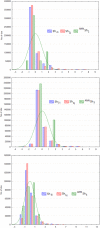Net-Net Auto Machine Learning (AutoML) Prediction of Complex Ecosystems
- PMID: 30120369
- PMCID: PMC6098100
- DOI: 10.1038/s41598-018-30637-w
Net-Net Auto Machine Learning (AutoML) Prediction of Complex Ecosystems
Abstract
Biological Ecosystem Networks (BENs) are webs of biological species (nodes) establishing trophic relationships (links). Experimental confirmation of all possible links is difficult and generates a huge volume of information. Consequently, computational prediction becomes an important goal. Artificial Neural Networks (ANNs) are Machine Learning (ML) algorithms that may be used to predict BENs, using as input Shannon entropy information measures (Shk) of known ecosystems to train them. However, it is difficult to select a priori which ANN topology will have a higher accuracy. Interestingly, Auto Machine Learning (AutoML) methods focus on the automatic selection of the more efficient ML algorithms for specific problems. In this work, a preliminary study of a new approach to AutoML selection of ANNs is proposed for the prediction of BENs. We call it the Net-Net AutoML approach, because it uses for the first time Shk values of both networks involving BENs (networks to be predicted) and ANN topologies (networks to be tested). Twelve types of classifiers have been tested for the Net-Net model including linear, Bayesian, trees-based methods, multilayer perceptrons and deep neuronal networks. The best Net-Net AutoML model for 338,050 outputs of 10 ANN topologies for links of 69 BENs was obtained with a deep fully connected neuronal network, characterized by a test accuracy of 0.866 and a test AUROC of 0.935. This work paves the way for the application of Net-Net AutoML to other systems or ML algorithms.
Conflict of interest statement
The authors declare no competing interests.
Figures
Similar articles
-
Testing the applicability and performance of Auto ML for potential applications in diagnostic neuroradiology.Sci Rep. 2022 Aug 11;12(1):13648. doi: 10.1038/s41598-022-18028-8. Sci Rep. 2022. PMID: 35953588 Free PMC article.
-
Evaluation of the performance of traditional machine learning algorithms, convolutional neural network and AutoML Vision in ultrasound breast lesions classification: a comparative study.Quant Imaging Med Surg. 2021 Apr;11(4):1381-1393. doi: 10.21037/qims-20-922. Quant Imaging Med Surg. 2021. PMID: 33816176 Free PMC article.
-
Human behavior in image-based Road Health Inspection Systems despite the emerging AutoML.J Big Data. 2022;9(1):96. doi: 10.1186/s40537-022-00646-8. Epub 2022 Jul 20. J Big Data. 2022. PMID: 35879937 Free PMC article.
-
Basic concepts of artificial neural network (ANN) modeling and its application in pharmaceutical research.J Pharm Biomed Anal. 2000 Jun;22(5):717-27. doi: 10.1016/s0731-7085(99)00272-1. J Pharm Biomed Anal. 2000. PMID: 10815714 Review.
-
Deep learning in spiking neural networks.Neural Netw. 2019 Mar;111:47-63. doi: 10.1016/j.neunet.2018.12.002. Epub 2018 Dec 18. Neural Netw. 2019. PMID: 30682710 Review.
Cited by
-
SCP4ssd: A Serverless Platform for Nucleotide Sequence Synthesis Difficulty Prediction Using an AutoML Model.Genes (Basel). 2023 Feb 28;14(3):605. doi: 10.3390/genes14030605. Genes (Basel). 2023. PMID: 36980878 Free PMC article.
References
Publication types
Associated data
LinkOut - more resources
Full Text Sources
Other Literature Sources
Miscellaneous



